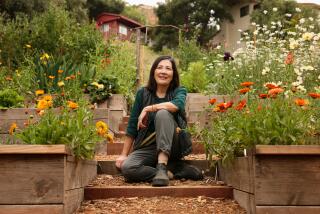Imaginative Planting Takes a Flowering Faith
Garden hobbyists are always looking for new, improved or dramatically different plants or varieties. Most comb catalogs for information on the latest horticultural happenings--or turn to nursery staffs for help.
Assistance comes in handy.
October is the best time for planting a garden in anticipation of colorful flowers next year, yet gardeners often have to use imagination and a little faith because most plants arenât flowering now.
We asked a few nursery experts to give us their favorite picks for the new year.
âThere are so many new and improved pansy varieties,â said Chris Greenwood of the Armstrong Garden Centers in Orange County. âBaby bingo pansies, new this year, are very heat tolerant and have very sturdy petioles, which permit the flowers to stand erect in rain or overhead watering. Flowers are larger than violas and smaller than giant-faced varieties and perform much better than the older Majestic Giants.â
Violas continue their popularity. This year, two new colors in the sorbet series--blue heaven and French vanilla--expand color selections to an even dozen.
Compact and low-growing, sorbet violas are floriferous. Blue heaven is purple with a yellow eye, and French vanilla is pure white with a small yellow eye.
Lew Whitney, president of Rogerâs Gardens in Corona del Mar, journeyed to the famed Chelsea Flower Show in London to scout for new plants.
âThe perennials knocked me out,â said Whitney, who created a video, âAn American Gardener at the Chelsea Flower Showâ (75 minutes, $30) to help local gardeners make selections.
He was particularly captivated by two new varieties of hardy geraniums, G. Stanhoe and G. harveyi.
âThese are neat clumping plants with unusually colored leaves,â Whitney said. âStanhoe has a dark gray leaf, and harveyi has small silvery-gray leaves. They complement each other when planted together.â
Whitney also recommends a new variety of gaura called Siskyou pink. Native to the Southwest, gaura is a long-flowering plant producing spikes of small flowers on leafless stalks. The plant grows to 3 feet with an equal spread and blooms from early spring through fall. The new variety produces masses of rose-pink flower stems.
âItâs a fabulous perennial, but at this time of year, youâve got to buy this plant on faith if you havenât seen it in bloom,â he said.
He recommends pairing gaura with Agastache âBlue Fortune.â Also known as giant hyssop, this perennial grows to 3 feet and produces spike-like clusters of vibrant blue flowers from spring through summer.
Gaura is also one of the recommendations of Mary Lou Heard, owner of Heardâs Country Gardens in Westminster. Heard seeks out perennial plants that can take the heat and dry conditions of Orange County gardens.
Always on the lookout for whatâs new or different, her picks include varieties that have been available but are becoming popular.
*
A noteworthy plant thatâs making inroads in Orange County gardens is Tanacetum niveum, a perennial that resembles feverfew. Heard values it for its finely filigreed foliage and mounds of white, daisy-like flowers that appear on the low-growing plant from spring through fall.
She also likes the new hybrids of Monarda didyma, popularly known as bee balm or Oswego tea. The plantâs new colors include clear pink Marshallâs delight and a smoky purple.
Forming clumps of 2 to 4 feet, bee balm in summer produces stems of tubular flowers that are favorites of hummingbirds. The aromatic leaves resemble the scents of mint and basil.
Look for Lysimachia ephemerum, popularly called gooseneck loosestrife. A vigorous plant that grows to 4 feet, with an equal spread, this variety sends up slender spikes of graceful white flowers in June and July. Leaves are gray-green.
Veronicas are sun-loving perennials that produce spikes of small flowers spring through summer. Heard recommends the new varieties V. austriaca teucrium Royal Blue, a low-growing ground cover bearing blue flowers, and V. Goodness Grows, which sends out 2-foot spikes of intense blue flowers.
Heard reports that Origanum rotundifolium Kent Beauty, though not new to the gardening world, is finally appearing in this region.
âItâs gorgeous,â she said. âItâs so showy with masses of delicate, pendulous flowers that are like a series of bells within each other.â
The sun-loving small plant, about 12 inches with an equal spread, can be used as an edging plant or in containers or window boxes that show off the trailing flower clusters. The long bloom season starts in March and continues into fall.
Heard says another useful border plant is Parahebe catarractae. Mounding to 14 inches, with a 20-inch spread, this perennial is related to Veronicas and has flowers similar in appearance. P. catarractae puts on its flower display in May and June, when itâs covered with masses of white flowers with fine pink veins.
Resembling penstemon but related to gloxinia, Incarvellia arguta is another of Heardâs selections. âItâs very pretty and indestructible in our climate.â
Growing to 2 feet with a 3-foot spread, this perennial bears pink flowers May through October.
Yellow flowers shine in Southern California gardens with the intense sunlight. A new cultivar, âSolidaster lemore,â has masses of tiny, lacy, pastel-yellow flowers midsummer through fall. This filler plant, Heard said, needs full sun and grows to 4 feet.
âItâs a spontaneous cross between Solidago, better known as goldenrod, and an aster,â Heard said. âItâs a lacy filler plant that grows from 3 to 4 feet and needs full sun.â






